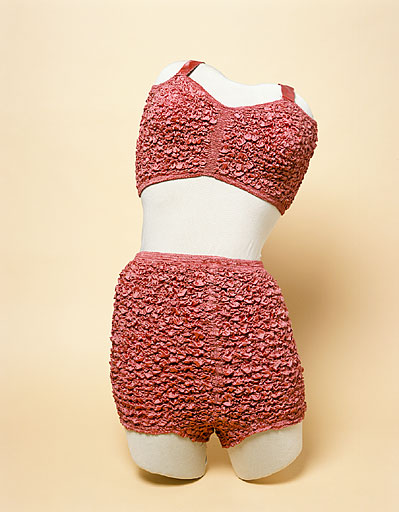bathing costume & bikini
Summary
Red and white shot rayon, ruched vertically and horizontally with parallel lines of elastic. Bra : Top edge rising for bust each side in front, with tie each side at front top edge to fasten round neck; lower edge straight; no fastenings; closer lines of parallel ruching down back and front. Knickers : Tubular, with short straight gusset; closer parallel lines of ruching to top edge.
Display Label
From the 1920s, simple all-in-one swimsuits in clinging machine-knitted wool jersey became fashionable, and were retailed by specialist firms such as Jantzen and Bukta. Stylised female figures in stylish swimming costumes were also used to decorate or advertise products by connecting them to healthy leisure pursuits, and the outdoor life (see the fan below). The first 2-piece swimsuits or "bikinis" revealing a bare midriff were worn from the late 1930s, although the term "bikini" was not used until after the war in the late 1940s. By the 1950s and 1960s, the fabric used for swimwear increasingly reflected mainstream fashion and costumes became more daring and vibrant, so that even a swimsuit from M&S would be made in a dramatic psychedelic print to attract the youth culture. By the mid-1960s more and more bare flesh was exposed, and women's swimwear could be very revealing. Avant guarde designers like Rudi Gernreich produced ever bolder styles which were featured in fashion magazines, notably his outrageous topless "Mono-kini" of 1964. Later designs included one-piece suits with bold, geometric cut-outs, revealing much of the wearer's body, and asserting that the body should be flaunted, not carefully covered up.
Object Name
bathing costume & bikini
Date Created
1946
Dimensions
Knickers: 25cm x 19cm
Bra: 21cm
accession number
1947.2865
Collection Group
Medium
Legal
© Manchester Art Gallery


